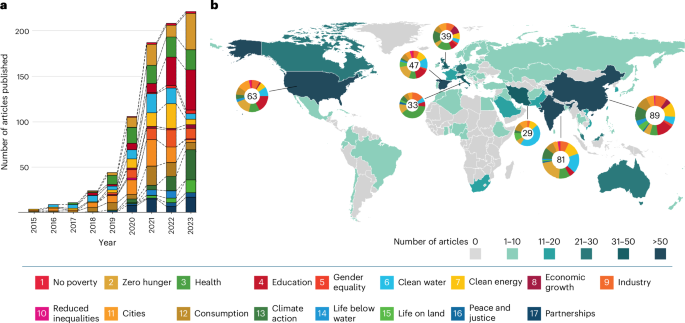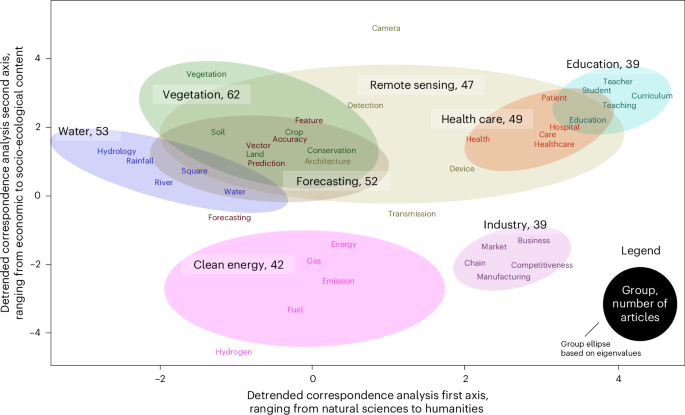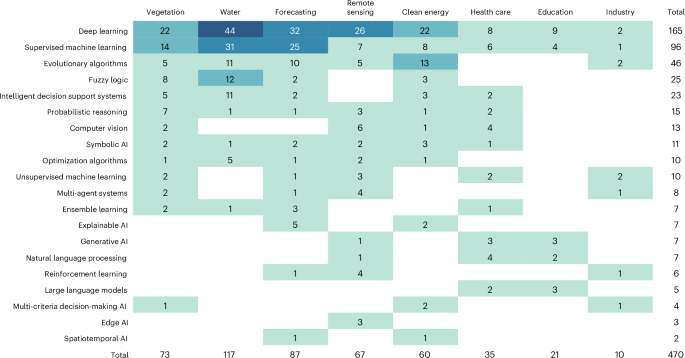可持续发展研究中的人工智能
作者:von Wehrden, H.
抽象的
人工智能(AI)通过实现数据驱动的见解和优化,具有巨大的潜力来促进可持续发展目标。在此分析中,我们回顾了792篇文章,这些文章探讨了与可持续发展目标相关研究中的AI应用程序。文献沿着两个维度组织:(1)从自然科学到人文科学的学科谱系,以及(2)重点,将经济与社会生态内容区分开来。深度学习和监督机器学习是用于预测和系统优化的最突出的算法。但是,我们确定了一个关键的差距:只有少数研究将先进的AI应用与深厚的可持续性专业知识相结合。可持续性需要在上下文化和普遍性之间取得平衡,以提供有形的知识,从而导致负责任的变革。AI必须在此过程中发挥核心作用。尽管对AI在可持续发展中的变革性作用的期望很高,但其全部潜力仍有待实现。
主要的
2015年联合国通过的2030年可持续发展议程为实现和平,繁荣和环境可持续性提供了全球蓝图,这是通过17个相互联系的可持续发展目标(SDGS)提供的。1。实现这些雄心勃勃的目标将需要综合和协作的方法,以应对相互关联的挑战,例如消除贫困,生态系统保护,建设和和平的经济增长2,,,,3。可持续性科学在这项努力中起着至关重要的作用,它通过确定能够实现系统级变化而不是浅层干预的解决方案4。人工智能(AI)的新兴进步为通过促进系统思维的方法和数据驱动的见解提供了新的机会,可以加速发展可持续发展目标。
AI对可持续发展的影响预计是直接和长期的,涵盖了积极和负面的结果5,,,,6。AI具有通过提供强大的工具(例如快速分析复杂数据集,预测气候趋势并应对关键挑战的能力)来彻底改变可持续发展研究的潜力。但是,AI领域的发展通常基于AI的要求和价值观7。该技术的分布也不均匀,其可承受能力与一个国家的经济潜力和动机高度联系8,,,,9。此外,AI开发的快速速度超过了确保其公平和可持续使用所需的道德和监管框架的建立10。结果,尚不确定AI是否代表可持续发展研究及其应用的真正范式转变。
我们对AI及其在与可持续发展的同行评审研究中的应用及其应用进行综述,以评估AI工具与有关可持续发展的深入了解的程度。通过解剖空间和时间特征以及研究焦点,我们通过研究可用的高度引用的文献来研究AI在与可持续发展可观的研究中的作用。
我们使用量身定制的提示从Scopus数据库中提取元数据,以针对每个SDG的相应政策领域,包括人工智能和可持续性的单词变化。我们分析了792篇文章的全文,这些文章符合与AI和一个或几个可持续发展目标的纳入标准。我们的分析确定了文献中的两个关键方面:(1)纪律轴,从自然科学到人文科学,以及(2)焦点轴,将重点关注经济学与关注社会生态学内容的经济学进行区分。尽管有AI的潜力,但我们的发现突出了一个关键的差距:很少有研究有效地桥接了具有深厚可持续性专业知识的先进的AI方法。解决这一脱节对于充分实现AI对可持续发展的承诺至关重要。
结果
概述
我们分析了将AI应用于可持续发展目标的792个同行评审的研究文章。随着时间的流逝,每年的文章数量大大增加,在2020年超过100张出版物,在2022年和2023年每年超过200个出版物(图。1a)。从地理上讲,大多数使用AI来解决可持续发展目标的研究起源于欧洲和亚洲(图。1B),有38%的分析文章(n= 303)由中国,印度,美国和西班牙的研究人员撰写。图1:分析的792个科学文章的全球分布和出版年。一个
例如,来自伊朗,印度和西班牙的研究专注于可持续发展目标6(清洁水和卫生),而意大利和英国的研究主要针对SDG 3(健康与福祉)。专注于可持续发展目标4的文章(质量教育)最常见于美国,西班牙和中国的作者发表。
我们将文章归类为经验(n= 393)和概念/评论(n= 399)文章。大多数经验文章都是由中国研究人员撰写的(n美国,美国(美国)(美国)(n= 29)和印度(n27)(补充图。5)。概念和评论文章主要源自印度的研究人员(n美国,美国(美国)(美国)(n= 34)和中国(n= 31)(补充图。8)。在下文中,我们将提供有关经验文章的全面概述。可以在补充信息中找到详细的结果描述和解释,包括概念和审查文章。实证研究中使用AI解决可持续发展目标的模式我们根据概念词汇使用了层次群集分析将文献分组,并使用指标物种分析确定了每个组的重要指标单词11。为了说明内容,结构和词汇量的差异,我们将样本分为经验文章,并评论/概念文章。这种分离确保聚类导致主题模式而不是结构差异。
我们的主要分析是关于经验文章,因为它们在特定的可持续性环境中直接应用AI算法(请参阅补充图。
2和3对于经验文章的方法学特性)。将组完善,直到不支持进一步的分离为止(补充图2。6和10)。
我们应用了降解的对应分析,以将数据集降低到两个主要的排序轴,从而最大程度地减少组内差异,同时最大化组差异12。由此产生的八组经验文章沿两个关键轴组织:(1)纪律轴:此轴心从自然科学到人文科学。关于健康和教育的文章出现了与水文系统和营养评估的研究更加紧密相关。
-
(2)
聚焦轴:此轴根据其方法区分文章。
-
AI驱动的研究在清洁能源和工业等领域具有潜在的经济目的与研究水文学或医疗保健的社会生态研究对比。
每个组的特征是五个指示单词,这些词突出了主题主题(图。
2和桌子1)。为了进行比较,补充图中提供了用于审查和概念文章的聚类结果。10。补充表中提供了每组经验文章的详细描述,包括相应的可持续发展目标和推荐的读数7。
第1组医疗保健(红色,49篇文章);第2组,植被(绿色,62篇文章);第3组,预测(Brown,52篇文章);第4组,水(蓝色,53篇文章);第5组,遥感(橄榄绿色,47篇文章);第6组,清洁能源(粉红色,42篇文章);第7组行业(紫罗兰,39篇文章);第8组教育(绿松石,39篇文章)。有关相同的单词分析,但适用于概念/评论文章,请参见补充图。9。为了避免由于文章长度极端的群集分析中的伪像,我们排除了十篇文章(补充图。11和12)。组标题基于每组最丰富的单词,其次是每组中的文章数量。组椭圆基于特征值。每个组都以五个最丰富的单词表示。轴标题是作者的模式解释。请参阅表1用于简短的描述和补充表7有关小组的完整描述。
AI的角色
为了更好地了解AI在可持续发展中的作用,我们使用机器学习分类法分析了AI的广泛领域13。由于机器学习代表了AI方法的主要子集,因此该框架与我们评论中的大多数经验应用一致,同时还涵盖了更广泛的AI环境(请参阅补充图。7为了分布AI在可持续发展目标中的作用)。
以下热图(图。3)显示了各组的AI应用程序的普遍性,突出了关键角色
-
(1)
预测:在清洁能源和植被中尤其突出,预测性见解支持资源管理和环境监测
-
(2)
系统优化:清洁能源广泛,反映了提高运营效率和性能的重点
-
(3)
数据挖掘和遥感:值得注意的是从非结构化数据中提取可行的见解,尤其是在医疗保健和遥感组中,强调了对数据驱动决策的日益增长的需求
-
(4)
加速实验和快速近似模拟:促进研究和初步分析的清洁能源和医疗保健专业工具(较不常见)
较深的颜色表示AI在可持续性主题中的作用。每个单元都代表着针对一个AI角色和一个可持续性主题的文章数量。并非所有383篇文章中使用的文章都出现在此处,因为某些经验文章没有指定AI的角色。加速实验,实验以加快设计过程;数据挖掘和遥感,原始数据翻译,例如文本文档或卫星图像中的可用见解;快速近似模拟,复杂系统和过程的快速建模;预测,通过从时间序列数据中学习对事件的预测;系统优化,控制和改善复杂系统的运营效率;预测性维护,维护系统以提高效率,降低成本并建立弹性。
总体模式表明,AI提高了不同部门的效率,韧性和可持续性,并具有反映部门需求和数据可用性的特定应用。
AI算法的选择由特定于组的需求,挑战和数据可用性强烈决定。从这个意义上讲,AI包含了各种各样的模型,其中一些模型重叠或相互嵌套(图。4)。例如,大型语言模型是一种深入学习自然语言处理的方法,但已成为深度学习的研究和应用的单独对象。见裁判。14,,,,15有关AI分类的进一步参考。例如,
-
深度学习和监督的机器学习算法主导了植被,水和清洁能源的应用。这些类型的AI用于系统优化(例如,可再生能源系统和电动汽车),能源和水需求预测以及污染预测和遥感图像分类,例如。16,,,,17。
-
进化算法允许在具有挑战性的情况下进行有效的优化,例如最大化可再生能源布局的效率,例如参考。18。
-
模糊逻辑算法提供了解释性和适应性,使其对于需要人类投入或解释性见解的建模系统有价值,例如参考。19。
-
自然语言处理算法正在成为医疗保健和教育中的关键工具,在这些工具中,非结构化或文本数据更为普遍。
但是,仍然存在许多差距。在教育和工业等群体中,AI通常被视为研究对象,而不是积极应用。这反映了对AI在组织中使用和影响的经验探索有限的,强调了进一步研究的机会。
讨论
尽管关于AI及其在可持续发展目标的应用越来越多的文献,但将AI方法与与可持续发展目标相关的研究深入整合的研究仍然令人惊讶地稀疏。大多数研究都集中在AI的技术方面或解决特定的可持续发展目标。迄今为止,几乎还没有实现AI工具用于解决复杂的可持续性挑战或有助于可持续发展目标的交叉点。
专注于本地研究和社会可持续性差距
尤其是自2019年以来,关于可持续发展研究的年度出版物的数量已大大增加,这与可持续性和AI研究的更广泛趋势一致,这证明了约600,000篇关于可持续性发表的文章(文章包括“可持续性*”的文章 - 单独发表的400,000篇文章,在第一个1024个月(第2024个月)发表了400,000篇文章(单独发表)(均为2024年)。涵盖1990年至2014年时期的文献综述首先记录了与AI相关的研究的迅速崛起,部分是由第三方资金和日益增加的全球利益驱动的20。这种趋势强调了可持续性和AI作为研究领域的高度相关性。虽然AI研究产出与早期研究中的第三方资金可用性呈正相关
20,只有在我们的研究中得到了部分证实。例如,西班牙,印度和伊朗在基于AI的分水岭建模的突出性反映了公认的研究传统21,,,,22。在西班牙,自1990年代以来,西班牙学者对AI的高度引用出版物已被记录20。同样,意大利对基于AI的可持续发展目标研究(身体健康)的显着关注与鼓励数据共享和协作的几项(国家)计划有关23,,,,24。中国的人工智能战略嵌入了新一代人工智能发展计划,直到2030年,通过大型投资优先考虑经济发展25。但是,我们的评论发现,大多数中国出版物都集中在气候变化,清洁能源和教育上,这清楚地表明了纯粹的经济目标偏离。
尽管取得了这种进步,但联合国2023年和2024年的可持续发展目标报告强调了2030年议程的进展,一半的可持续发展目标是轨道上的一半目标,而数据在2023年的大多数目标都不足26,,,,27。联合国主张AI支持可持续发展目标26,但差距仍然存在。例如,AI广泛用于健康,教育和环境建模,但其在减贫(SDG 1)中的使用量很少。我们在最引用的文献中只发现了七个评论,没有实证研究,该文献将AI应用于SDG 1(没有贫困)。鉴于预计有5.75亿在2030年生活在极端贫困中,这一发现令人惊讶26。关于贫困的研究主要依赖于定性方法或人口统计数据的分析。28,很少有AI驱动方法的贫困预测工具的示例29。
在过去的十年中,机器学习,深度学习和进化算法的扩散对环境可持续性研究产生了深远的影响。这些方法在处理大规模,基于传感器和图像富的数据集方面表现出色,这使得它们在诸如植被监测,水资源管理和清洁能源优化之类的任务中特别有效。例如,它们用于通过卫星图像跟踪植被变化,预测水位并优化可再生能源网格性能30。尤其是进化算法已被证明在复杂的优化问题中有用,例如风电场布局和太阳能电池板配置,同时平衡环境和经济目标31。
与其环境应用相反,AI在社会可持续性领域(例如决策,可持续发展教育和社会公平教育和社会公平的教育)中仍未得到充分利用,这对可持续发展目标至关重要。除了某些研究领域的历史过多,这种差异32,是由于几个挑战:
-
(1)
社会数据的复杂性:社会系统涉及难以定性建模的定性和上下文变量。
-
(2)
道德约束:隐私法律和道德问题限制了对人类行为数据的访问。
-
(3)
监督学习局限性:许多AI方法需要稀疏和上下文依赖于政治和社会领域的大型标签的数据集33。
这些局限性在AI应用程序中有了显着的差距,以实现可持续发展的临界维度,例如可持续发展10(减少的不平等)和SDG 16(和平,正义和强大的机构)。解决这些差距需要更多包容性的数据框架,以说明定性和上下文丰富的变量,更大的跨学科合作,以将AI与社会科学融为一体,以及针对社会系统复杂性量身定制的算法创新5。我们的分析表明,关于可持续发展研究中AI的文献体系逐渐增加。但是,许多AI用户倾向于采用技术自动或生态现代主义的观点,或与其他观点保持一致,将技术定位为朝着解决方案迈进的巨大飞跃。相应地,使用AI来从事社会可持续性解决方案可能需要更深刻的心态转变3。
很少有研究社区的纪律人工智能技术
这项研究中大多数经验文章的区域范围反映了研究的主题重点和方法论性质。例如,许多研究涉及区域分水岭评估,例如参考文献。34,,,,35。其他特定于地区的应用程序包括评估教育中的AI工具,例如单个学习平台,例如参考。36,优化温室的能源消耗37。相比之下,我们发现的少数全球经验研究主要解决了系统优化,数据挖掘和遥感。38,,,,39。但是,全球研究数量有限,可能是由于AI方法的复杂性和高计算需求,这仍然是大规模应用的实质性障碍40。
尽管可持续发展固有地需要变革性的纵向研究(图。2),大多数实证研究都集中在当前并使用定量方法。这与医疗保健研究的先前观察结果一致,在该研究中,AI驱动的研究很少解决时间动态41。此外,可持续发展目标术语通常是一种修辞手段,而不是可行的见解或变革性变化的基础42。我们的发现表明,AI方法与可持续发展研究之间的联系仍然很新生,其特征是实验应用和流行语使用,而不是对可持续性目标的实质性贡献。
当前的研究格局高度分散,在水资源管理,植被监测,能源系统和污染控制等技术领域的预测和优化方面存在明显的纪律偏见。这反映了AI开发的持续实验阶段,随着研究人员继续探索其推动可持续发展目标的潜力5。但是,在自然语言处理应用程序(例如CHATGPT和其他生成AI技术)中的新兴突破有望改变研究的重点。在接下来的几年中,AI应用可能会扩展到社会科学,心理学和教育,从而对社会变化进行更细微的调查43,,,,44。
可持续发展目标的纪律重点
如图2所示,可持续发展研究中的纪律鸿沟。2,是有据可查的现象。虽然越来越多的跨学科文献挑战了这一鸿沟45,在我们的分析中出现了两个不同的模式。首先,研究重点是AI的应用和使用AI作为一种方法论方法来提高有关可持续发展知识的方法学方法的研究。例如,预测是智能农业和清洁能源研究中的一种常见技术,但前者强调图像检测的遥感,而后者则侧重于网格和物理系统优化46,,,,47。
大多数可持续发展目标直接在我们发现的组中直接表示,包括可持续发展目标3(健康),可持续发展目标4(教育),SDG 6(水),SDG 7(清洁能源)和SDG 15(陆地上的寿命)。尽管在这些领域多年来广泛使用了人工智能,但这些研究的可持续性概念化仍然很弱(补充图。4)。这种狭窄的框架反映了纪律孤岛,从而导致因果推理,通常与以解决方案为导向的,系统级别的可持续性科学议程不一致48。实现可持续发展目标17(目标的合作伙伴关系)将需要所有可持续发展目标的跨学科研究途径,这可能会受到本研究中AI的各种应用的催化。例子包括AI在促进协作,支持数据集成以及桥接学科界限中的作用,以应对复杂的可持续性挑战。
但是,仍然存在显着的差距。
基于AI的贫困研究(SDG 1)和性别(SDG 5)的代表性不足(补充图。1)。对于贫困,我们只发现了七篇评论文章,而对于性别,有八篇文章(五篇经验和三个概念或评论)。尽管它的基本重要性27,贫困通常以经济福利为基础49或作为更广泛的可持续发展指标的隐含组成部分,例如GDP或包容性福利50。特别是,在农村环境中,智能农业被视为贫困中的一条途径51。
性别(SDG 5)研究主要集中于研究本身的偏见,例如,在加拿大AI研究中的性别代表性研究中52。在医疗保健中,AI算法通常不考虑性别和性别偏见53,限制他们的公平和有效性。解决此类差异对于在可持续发展领域的AI应用中提高社会公平和包容性至关重要。某些可持续发展目标,例如与行业和消费有关的可持续发展目标,甚至在正式介绍可持续发展目标之前,与人工智能和数据驱动的分析一直与AI和数据驱动的分析密切相关。结果,这些可持续发展目标被更广泛的科学文献所覆盖。相比之下,其他可持续发展目标,例如贫困和性别平等,没有类似的AI驱动定量数据分析传统。尽管在性别研究等领域存在相关的数据源,但解决这一研究差距仍然是从事这些特定可持续发展目标的社区的未来挑战。
我们研究的局限性
我们的分析有几个局限性,这源于我们评论的范围和方法。首先,我们的选择文章受到针对AI与可持续发展目标之间相交的搜索词的约束。由于可持续发展目标代表了政治框架和政策妥协,因此许多探讨可持续性与AI之间更广泛交集的文章可能未包含在我们的数据集中。其次,我们对最被引用的文章的关注引入了对公认的研究的潜在偏见,这可能会错过引用计数较低的新兴研究(补充信息我和补充表4和5)。第三,可持续发展目标以及AI社区都经常通过政策报告或会议程序发布发现,这会造成与同行审查过程持续时间相关的延迟。这导致了基于期刊的文献中新兴模式的可见性的滞后。尽管我们的分析有这些局限性,但我们认为,我们综述中确定的模式是稳健的,并且不太可能随着更多先前发表的文献或灰色文献而发生重大变化。但是,该领域的未来发展自然可能会完善或扩展此处提出的发现。
我们的工作为稳固的基础提供了关于以AI为中心和以可持续发展目标的科学文献之间相交的现行现状的更深入的讨论。我们介绍了迄今为止发表的文献中的模式,以促进未来文献的变化。我们强调了两个新兴研究领域之间的差距和缺乏更深层次的联系。因此,我们评论的主要目的是介绍当前文献的概述,理想情况下,刺激了关于AI和可持续性的讨论,并强调新的思维方式需要出现。显然,除了对未来轨迹的更深入的讨论之外,这显然超出了这一评论。但是,我们希望通过就更大的整合进行批判性辩论来做出贡献。
当前文献和前景的局限性
所回顾的文献广泛反映了可持续性的三个支柱:社会,环境和经济54。但是,AI在特定可持续发展目标中的应用中仍然存在显着差距。具体而言,可持续发展目标1(无贫困),可持续发展目标5(性别平等)和可持续发展目标17(目标伙伴关系)仍然严重不足。这些目标是SDG框架的基础,突出了经济进步与社会福祉之间的相互依存关系55。他们在人工智能和可持续性研究中的相对忽视加剧了气候不公,并破坏了跨学科以及科学与社会之间的长期和包容性合作的能力。
跨可持续发展目标的文章分布不均,部分是由于AI在当前文献中的定义和应用不同。许多研究采用了对可持续性的广泛或不确定的理解,通常在不提供明确定义的情况下使用该术语。缺乏概念上的清晰度反映了一个更广泛的问题:大多数研究仅限于系统知识,无法解决可持续性科学核心的规范或变革性维度。与AI相关的道德考虑对于研究和政策显然很重要,但是这些研究几乎完全没有被评论的研究。除了这篇综述之外,它们仍然高度分散且不足。Prominent ethical debates typically revolve around the optimization of energy use, so-called ‘Green AI’, the growing energy demand due to AI, the efficiency of production and consumption processes, and the accessibility and confidentiality of training and test data56,,,,57,,,,58。However, there are deeper and often more tacit debates about national AI systems, their use, and the competitive dynamics between countries.Moreover, broader concerns about the potential risks of AI—such as its ability to control and disempower citizens, or even pose existential threats to humanity—are also central to these debates59,,,,60,,,,61。Although the data sources examined in this review underscore the importance of these issues, a comprehensive and substantial body of literature addressing them remains largely absent from the available literature.This omission contrasts sharply with the normative and values-driven nature of sustainability, which seeks to address profound societal challenges through inclusive and ethical solutions.
In addition, AI itself poses potential risks to sustainability, such as its high energy consumption and other environmental impacts, which can exacerbate challenges such as climate change.This highlights the responsibility of researchers to ensure that AI applications are consistent with sustainability principles and make a positive contribution to our common future.
While research on the intersection between AI and sustainability has grown exponentially in recent years, many SDGs remain underexplored.Current research often represents an innovative but opportunistic starting point, with limited integration across disciplines or transformative contributions to sustainability goals.To address these gaps, a more integrated research agenda is needed—one that emphasizes interdisciplinary collaboration, ethical considerations and the normative aspects of sustainability.Such an agenda has the potential to advance the role of AI as a transformative tool for achieving sustainable development in the years to come.
方法
Our methodological approach is based on a content analysis as used in previous bibliometric analyses12,,,,62,,,,63,,,,64,,,,65,,,,66。The approach largely follows standard procedures for accessing and filtering literature databases, and employs a unique set of multivariate statistical full-text analyses for pattern recognition, which are described in the following.
Data collection and coding
To investigate the interplay between sustainable development research and the use of AI, we queried metadata from the Scopus database in January 2024 for each of the 17 SDGs on the basis of the following criteria: (1) use of the term ‘AI’, ‘A.I.’ or ‘Artificial Intelligence’ in article title, abstract or keywords;(2) occurrence of the term ‘sustainab*’;(3) use of SDG-specific conceptual vocabulary;(4) publication as a peer-reviewed scientific journal article;and (5) publication in English language (see overview in Supplementary Table2)。We adapted the search strings for each SDG on the basis of the respective SDG description texts to produce sufficiently many relevant hits from the database, resulting in a total number of 14,423 articles.See Supplementary Information我for a detailed list of search strings in Supplementary Table3and coding scheme in Supplementary Table6, and Supplementary Data1for the list of 792 investigated articles.For each SDG, we sorted the Scopus hits according to citations per year.
Two reviewers each screened the abstracts to ensure the inclusion of articles that contribute to the discourses on AI, sustainability and the respective SDG beyond buzzwords.Our target was to include the 100 most cited articles per SDG.Articles with more than 30 citations started to rapidly increase from 2018 and peaked in 2021 (Supplementary Table4)。While fewer recent articles (for example, 2023) were expected to be included due to our sampling approach, some highly cited articles from 2023 were included nonetheless (Supplementary Table5)。In cases where only a few articles were published on a particular SDG, the target of 100 articles was not met.The hits for SDG 17 did not yield any tangible results;we therefore had to exclude it from the review process entirely.We obtained PDFs of all accessible articles, and to ensure inter-coder reliability, we conducted the full-text analysis again in reviewing teams.We further excluded articles that did not meet the initial inclusion criteria in the full-text analysis but replaced them from the hit list to maintain 100 articles per SDG when possible.
The reviewing teams discussed articles that appeared as duplicates in multiple SDGs and reassigned them to the SDG with a better thematic fit.In this step, we did not replace the reassigned articles but reduced the total number per SDG because the reassigned articles remained in the study.
On the basis of an initial screening of ten articles per SDG, we developed a coding scheme that was further adapted during multiple rounds of implementation and refinement with all authors.This inductive approach resulted in a robust set of categories (Supplementary Table6), which we then applied to all articles.We distinguished between empirical, conceptual and review articles.We combined the set of conceptual and review articles into one category, because many of the reviews on artificial intelligence and sustainable development are non-systematic and closely related to conceptual papers, but both differ in their approach and structure from empirical articles.
数据分析
We further analysed the empirical literature (n = 393) and review and conceptual articles (n = 399) using a multivariate statistical full-text analysis63。For this analysis, we extracted words from the PDF files using Python and filtered for nouns only.We then put these words into text files to import them into R. Articles with extreme word counts were removed (Supplementary Figs.11和12) because they formed separate clusters due to word count rather than meaningful word abundance patterns.This ensured clustering was based on shared abundance distributions rather than text length artefacts (see the Extended Methodology Description in补充信息有关更多详细信息)。
For the empirical articles, we removed 10 articles due to extreme word count and included only the 20% most frequent words to reduce noise and sparsity, resulting in a list of 1,579 words out of 7,990.For the review and conceptual articles, we removed 16 articles due to extreme count and, by also considering the 20% most frequent words, the final sample of words resulted in 1,948 words out of 9,877.
Assuming that different research communities use a unique set of conceptual vocabulary, groups within the literature were differentiated using hierarchical cluster analysis based on a list of conceptual vocabulary that was obtained from the filtered list of words.We then used an indicator species analysis11to find significant indicator words for all respective groups.These groups were further separated until no significant indicator words supported any more groups.On the basis of the total set of words, we performed a detrended correspondence analysis to reduce the multivariate corpus and visualize it on the two primary ordination axes.Within this multivariate space, significant indicator words were restricted to five words per group to allow the visual clustering of the groups.The method uses minimum variance as the criterion for clustering articles, hence minimizing variance within groups while maximizing differences between groups12。A detailed description of the analysis is part of the补充信息。
报告摘要
Further information on research design is available in theNature Portfolio Reporting Summarylinked to this article.
数据可用性
The original data used in this study were obtained through a query of the Scopus database and are included in the补充信息。The Supplementary Data1presents the list of 792 articles analysed in this study along with the corresponding identified groups and additional metadata.The database can be accessed via Github athttps://github.com/datagus/ai_sdg_review。源数据are provided with this paper.代码可用性
The code can be accessed via Github at
https://github.com/datagus/ai_sdg_review。参考
Transforming Our World: The 2030 Agenda for Sustainable Development
(United Nations, 2015).Allen, C., Metternicht, G. & Wiedmann, T. Initial progress in implementing the Sustainable Development Goals (SDGs): a review of evidence from countries.
维持。科学。 13, 1453–1467 (2018).
Abson, D. J. et al.Leverage points for sustainability transformation.Ambio 46, 30–39 (2017).
Fuso Nerini, F. et al.Connecting climate action with other Sustainable Development Goals.纳特。维持。 2, 674–680 (2019).
Vinuesa, R. et al.The role of artificial intelligence in achieving the Sustainable Development Goals.纳特。社区。 11, 233 (2020).
CAS一个 Google Scholar一个
Korinek, A. & Juelfs, M.Preparing for the (Non-existent?) Future of Work(National Bureau of Economic Research, 2022).
Goralski, M. A. & Tan, T. Artificial intelligence and sustainable development: the AI4SDGs project.AI Soc. 35, 677–684 (2020).
Meitei, A. J., Rai, P. & Rajkishan, S. S. Application of AI/ML techniques in achieving SDGs: a bibliometric study.环境。开发维持。 27, 281–317 (2023).
Wegren, S. K. Food security and Russia’s 2010 drought.Eurasian Geogr.Econ。 52, 140–156 (2011).
de Almeida, P. G. R., dos Santos, C. D. & Farias, J. S. Artificial intelligence regulation: a framework for governance.Ethics Inf.技术。 23, 505–525 (2021).
Dufrêne, M. & Legendre, P. Species assemblages and indicator species: the need for a flexible asymmetrical approach.Ecol.Monogr. 67, 345–366 (1997).
Rathgens, J., Gröschner, S. & von Wehrden, H. Going beyond certificates: a systematic review of alternative trade arrangements in the global food sector.J.清洁。产品。 276, 123208 (2020).
Kaack, L. H. et al.Aligning artificial intelligence with climate change and sustainability goals.环境。res。Lett。 17, 044019 (2022).
Soori, M., Arezoo, B. & Dastres, R. Artificial intelligence, machine learning and deep learning in advanced robotics: a review.Cogn。机器人。 3, 54–70 (2023).
Judge, M. A. et al.A comprehensive review of artificial intelligence approaches for smart grid integration and optimization.Energy Convers.管理。 24, 100724 (2024).
Elahi, E., Weijun, C., Jha, R., Hadri, E. H. & Saeed, A. Deep learning-based crop classification and yield estimation: a case study of wheat disease in Pakistan.计算。电子。农业。 161, 51–60 (2019).
Shreyas Madhav, V., Trivedi, K., Pandian, A. & Yegnanarayana, B. Deep learning for time series forecasting in renewable energy systems: recent advances and challenges.更新。维持。Energy Rev. 156, 111976 (2022).
Chen, X., Cao, W., Zhang, Q., Hu, S. & Zhang, J. Artificial intelligence-aided model predictive control for a grid-tied wind-hydrogen-fuel cell system.IEEE Access 8, 92418–92430 (2020).
Abba, S. I. et al.Fuzzy logic modeling of renewable energy resources: a review.Energy Rep. 6, 177–195 (2020).
Niu, J., Tang, W., Xu, F., Zhou, X. & Song, Y. Global research on artificial intelligence from 1990–2014: spatially-explicit bibliometric analysis.ISPRS Int.J. Geoinf. 5, 66 (2016).
Satheeshkumar, N. & Ravi, R. Artificial intelligence applications in watershed management: recent advancements and future prospects.Water Pract.技术。 19, 411–420 (2024).
Daniel, E., Wilson, H. & Myers, A. Adoption of e-commerce by SMEs in the UK.int。Small Bus.J. 20, 253–270 (2011).
Avanzo, M. et al.Artificial intelligence applications in medical imaging: a review of the medical physics research in Italy.Physica Med. 83, 221–241 (2021).
Secinaro, S., Calandra, D., Secinaro, A., Muthurangu, V. & Biancone, P. The role of artificial intelligence in healthcare: a structured literature review.BMC Med。通知。决策。Mak. 21, 1–23 (2021).
Wu, F. et al.Towards a new generation of artificial intelligence in China.纳特。Mach.Intell。 2, 312–316 (2020).
The Sustainable Development Goals Report 2023(United Nations, 2023).
The Sustainable Development Goals Report 2024(United Nations, 2024).
Ridzuan, M. I. M., Morshidi, A. B., Zakaria, N. S., Idris, R. Z. & Jambol, D. J. A. Unraveling the nexus: exploring Malaysia’s research trends in advancing UN SDG 1.多阶层。修订版 8, 2025050 (2025).
Usmanova, A., Aziz, A., Rakhmonov, D. & Osamy, W. Utilities of artificial intelligence in poverty prediction: a review.可持续性 14, 14238 (2022).
Rolnick, D. et al.Tackling climate change with machine learning.ACM Comput.Surv. https://doi.org/10.1145/3485128(2023)。
Oliveira, L. S. et al.Evolutionary algorithms in environmental and energy applications: review and analysis.更新。维持。Energy Rev. 143, 110908 (2021).
Gao, L. & Wang, T. AI and social sciences: a systems perspective.系统 12, 10 (2024).
Hino, M., Benami, E. & Brooks, N. Machine learning for environmental monitoring.纳特。维持。 1, 583–588 (2018).
Masciopinto, C., Vurro, M., Palmisano, V. N. & Liso, I. S. A suitable tool for sustainable groundwater management.水资源。管理。 31, 4133–4147 (2017).
Sharda, V. N., Patel, R. M., Prasher, S. O., Ojasvi, P. R. & Prakash, C. Modeling runoff from middle Himalayan watersheds employing artificial intelligence techniques.农业。Water Manage. 83, 233–242 (2006).
Singh, R. et al.A data-driven framework for monitoring social distancing in educational institutions using AI.J. Ambient Intell.Humaniz.计算。 13, 4017–4027 (2022).
Ajagekar, A. & You, F. Machine learning for uncovering hidden opportunities in high-performance simulation of sustainable systems.ACS维持。化学工程。 11, 3362–3371 (2023).
Bellantuono, L. et al.Worldwide impact of lifestyle predictors of dementia prevalence: an explainable artificial intelligence analysis.正面。大数据 5, 1027783 (2022).
Chakraborty, D. et al.Scenario-based prediction of climate change impacts on building cooling energy consumption with explainable artificial intelligence.应用。活力 291, 116807 (2021).
Rather, I. H., Kumar, S. & Gandomi, A. H. Breaking the data barrier: a review of deep learning techniques for democratizing AI with small datasets.艺术品。Intell。修订版 57, 226 (2024).
Carrasco-Ribelles, L. A. et al.Prediction models using artificial intelligence and longitudinal data from electronic health records: a systematic methodological review.J. Am。医学通知。联合。 30, 2072–2082 (2023).
Malyuga, E. & Rimmer, W. Sustainable development discourse: linguistic features and translation challenges.Heliyon 7, e07334 (2021).
Demszky, D. et al.Using large language models in psychology.纳特。Psychol牧师。 2, 688–701 (2023).
Gan, W., Sun, Y., & Yu, X. Integrating educational assessment and generative AI for personalized knowledge building: an exploratory study.在Proc。2024 International Conference on Intelligent Education and Intelligent Research (IEIR)1–8 (IEEE, 2024).
Cao, L. Trans-AI/DS: transformative, transdisciplinary and translational artificial intelligence and data science.int。J. Data Sci.肛门。 https://doi.org/10.1007/s41060-023-00383-y(2023)。
Hussain, A., Bui, V. H. & Kim, H. M. Microgrids as a resilience resource and strategies used by microgrids for enhancing resilience.应用。活力 240, 56–72 (2019).
Zhang, Y. et al.Capacity configuration optimization of multi-energy system integrating wind turbine/photovoltaic/hydrogen/battery.活力 252, 124046 (2022).
CAS一个 Google Scholar一个
Schlüter, M. et al.Navigating causal reasoning in sustainability science.Ambio 53, 1618–1631 (2024).
Ravallion, M. On measuring global poverty.安努。Econ牧师。 12, 167–188 (2020).
Managi, S., Chen, S., Kumar, P. & Dasgupta, P. Sustainable matrix beyond GDP: investment for inclusive growth.Humanit.Soc。科学。社区。 https://doi.org/10.1057/s41599-024-02659-5(2024)。
Florey, C., Hellin, J. & Balié, J. Digital agriculture and pathways out of poverty: the need for appropriate design, targeting, and scaling.Enterp.开发小额信贷 31, 126–140 (2020).
Daraz, L., Chang, B. S. & Bouseh, S. Inferior: the challenges of gender parity in the artificial intelligence ecosystem—a case for Canada.正面。艺术品。Intell。 5, 931182 (2022).
Cirillo, D. et al.Sex and gender differences and biases in artificial intelligence for biomedicine and healthcare.NPJ Digit.医学 3, 81 (2020).
Purvis, B., Mao, Y. & Robinson, D. Three pillars of sustainability: in search of conceptual origins.维持。科学。 14, 681–695 (2019).
Folke, C., Biggs, R., Norström, A. V., Reyers, B. & Rockström, J. Social-ecological resilience and biosphere-based sustainability science.Ecol.Soc。 21, 41 (2016).
Strubell, E., Ganesh, A. & McCallum, A. Energy and policy considerations for modern deep learning research.在Proc。AAAI Conference on Artificial Intelligence https://doi.org/10.1609/aaai.v34i09.7123(2020)。
Verdecchia, R., Sallou, J. & Cruz, L. A systematic review of Green AI.Wiley Interdiscip。Rev. Data Min.知识。Discov。13, e1507 (2023).Shiriaev, E. M., Nazarov, A. S., Kucherov, N. N. & Babenko, M. G. Analytical review of confidential artificial intelligence: methods and algorithms for deployment in cloud computing.
程序。计算。软件。 50, 304–314 (2024).
Federspiel, F., Mitchell, R., Asokan, A., Umana, C. & McCoy, D. Threats by artificial intelligence to human health and human existence.BMJ Glob.健康 8, e010435 (2023).
Wang, X., Zhang, Y. & Zhu, R. A brief review on algorithmic fairness.管理。系统。工程。 1, 7 (2022).
Jungherr, A. Artificial intelligence and democracy in the digital age.Policy Internet 15, 197–215 (2023).
Brandt, P. et al.A review of transdisciplinary research in sustainability science.Ecol.Econ。 92, 1–15 (2013).
Abson, D. J. et al.Ecosystem services as a boundary object for sustainability.Ecol.Econ。 103, 29–37 (2014).
Engler, J. O. et al.15 years of degrowth research: a systematic review.Ecol.Econ。 218, 108101 (2024).
Nüchter, V., Abson, D. J., Von Wehrden, H. & Engler, J. O. The concept of resilience in recent sustainability research.可持续性 13, 2735 (2021).
Drupp, M. A., Baumgärtner, S., Meyer, M., Quaas, M. F. & von Wehrden, H. Between Ostrom and Nordhaus: the research landscape of sustainability economics.Ecol.Econ。 172, 106620 (2020).
致谢
The authors received no specific funding for this work.
资金
Open access funding provided by Leuphana Universität Lüneburg.
竞争利益
作者没有宣称没有竞争利益。
同行评审
同行评审信息
自然的可持续性
thanks George Feretzakis, Daniel Yoo and the other, anonymous, reviewer(s) for their contribution to the peer review of this work.附加信息
Publisher’s note
关于已发表的地图和机构隶属关系中的管辖权主张,Springer自然仍然是中立的。补充信息
源数据
Source Data Figs.
1a,b and 2–4.
Excel document with five sheets, one sheet for each of the Figs.1a,b and 2–4, and their corresponding source data information.
权利和权限
开放访问本文允许以任何媒介或格式的使用,共享,适应,分发和复制允许使用,分享,适应,分发和复制的国际许可,只要您适当地归功于原始作者和来源,就可以提供与创意共享许可证的链接,并指出是否进行了更改。The images or other third party material in this article are included in the article’s Creative Commons licence, unless indicated otherwise in a credit line to the material.If material is not included in the article’s Creative Commons licence and your intended use is not permitted by statutory regulation or exceeds the permitted use, you will need to obtain permission directly from the copyright holder.To view a copy of this licence, visithttp://creativecommons.org/licenses/by/4.0/。重印和权限
引用本文
Gohr, C., RodrÃguez, G., Belomestnykh, S.
等。Artificial intelligence in sustainable development research.Nat Sustain(2025)。https://doi.org/10.1038/s41893-025-01598-6
已收到:
公认:
出版:
doi:https://doi.org/10.1038/s41893-025-01598-6
关于《可持续发展研究中的人工智能》的评论
暂无评论




